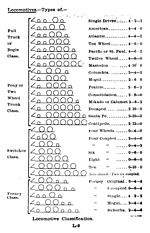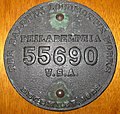A tank locomotive is a steam locomotive which carries its water in one or more on-board water tanks, instead of a more traditional tender. Most tank engines...
33 KB (3,819 words) - 22:41, 13 August 2024
Thomas the Tank Engine is an anthropomorphised fictional tank locomotive in the British Railway Series books by Wilbert Awdry and his son, Christopher...
24 KB (2,611 words) - 16:56, 2 September 2024
0-6-0 (category 0-6-0 locomotives)
this was the most common wheel arrangement used on both tender and tank locomotives in versions with both inside and outside cylinders. In the United Kingdom...
39 KB (4,996 words) - 03:46, 10 June 2024
0-4-0 (category 0-4-0 locomotives)
rods to form a single driven set. The notation 0-4-0T indicates a tank locomotive of this wheel arrangement on which its water and fuel is carried on...
31 KB (3,855 words) - 22:09, 25 August 2024
A steam locomotive is a locomotive that provides the force to move itself and other vehicles by means of the expansion of steam.: 80 It is fuelled by...
146 KB (17,879 words) - 10:12, 22 August 2024
Southend Railway (LT&SR). The 4-4-2T is the tank locomotive equivalent of a 4-4-0 American type tender locomotive, but with the frame extended to allow for...
26 KB (3,211 words) - 03:17, 3 July 2024
Tender (rail) (redirect from Tender (locomotive))
fuel and water on board the locomotive itself are called tank locomotives or tank engines. A corridor tender is a locomotive tender with a passageway to...
27 KB (3,305 words) - 22:13, 7 July 2024
Whyte notation (redirect from 4w (locomotive))
can be used to extend the Whyte notation for tank locomotives: Various other types of steam locomotive can be also denoted through suffixes: The wheel...
31 KB (1,780 words) - 05:44, 18 August 2024
4-6-2 (redirect from Pacific (locomotive))
wheels as a means of reducing its axle load. In 1896, six Q class 4-6-2 tank locomotives were introduced on the Western Australian Government Railways. The...
125 KB (16,871 words) - 14:20, 30 May 2024
A crane tank locomotive (CT) is a steam locomotive fitted with a crane for working in railway workshops, docksides, or other industrial environments. The...
3 KB (264 words) - 00:26, 10 June 2023
0-4-2 (category 0-4-2 locomotives)
side-tank locomotive, 0-4-2ST for a saddle-tank locomotive, 0-4-2WT for a well-tank locomotive and 0-4-2RT for a rack-equipped tank locomotive. The earliest...
17 KB (2,103 words) - 02:07, 6 July 2024
0-6-2 (category 0-6-2 locomotives)
wheels on one axle. While some locomotives with this wheel arrangement had tenders, the majority were tank locomotives which carried their coal and water...
14 KB (1,667 words) - 16:31, 19 June 2024
2-8-2 (redirect from Mikado (locomotive))
2-8-2T indicates a tank locomotive of this wheel arrangement, the "T" suffix indicating a locomotive on which the water is carried in tanks mounted on the...
64 KB (8,562 words) - 11:02, 3 September 2024
2-8-4 (redirect from Berkshire locomotive)
was mostly seen in mainline passenger express locomotives and, in certain countries, in tank locomotives. In the United States of America, the 2-8-4 wheel...
52 KB (5,978 words) - 17:24, 27 August 2024
and two NZR 2-6-2 Wb tank locomotives and one Wd tank locomotive are in the early stages of restoration. Another steam locomotive that is preserved is...
62 KB (7,679 words) - 19:37, 3 August 2024
4-4-0 (redirect from 4-4-0 locomotive)
The vast majority of 4-4-0 locomotives used tenders, though some tank locomotives were built. Five years after new locomotive construction had begun at...
42 KB (4,738 words) - 21:50, 26 August 2024
4-6-4 (category 4-6-4 locomotives)
for passenger tank locomotives. As such, it was essentially the tank locomotive equivalent of a 4-6-0 tender locomotive, with water tanks and a coal bunker...
55 KB (6,381 words) - 22:19, 30 August 2024
(GWR) experimented with oil burning steam locomotives at two points in its history. A single experimental tank engine was constructed to burn oil in 1902...
13 KB (963 words) - 16:29, 6 September 2024
turbine number: number of cylinders t: tank locomotive tr: tram (urban) locomotive E: Engerth-type locomotive G: freight (German: Güterzug, lit. 'goods...
8 KB (1,039 words) - 13:16, 11 July 2024
4-6-0 (category 4-6-0 locomotives)
A 4-6-0 steam locomotive, under the Whyte notation for the classification of steam locomotives by wheel arrangement, has four leading wheels on two axles...
69 KB (9,022 words) - 16:29, 15 August 2024
2-8-0 (redirect from Consolidation (locomotive))
indicates a tank locomotive of this wheel arrangement, the "T" suffix indicating a locomotive on which the water is carried in side-tanks mounted on the...
47 KB (6,018 words) - 11:20, 3 September 2024
Saddle tank may refer to: Saddle tank (locomotive), a water tank carried above the boiler of a steam locomotive; also the type name of a locomotive so fitted...
309 bytes (79 words) - 01:45, 15 August 2012
GWR 5700 Class (category Great Western Railway locomotives)
tank locomotives in 1860, and this continued into the BR era until 1956, with a total of 2,393 being built. The GWR also used 0-6-0 tank locomotives from...
110 KB (7,726 words) - 10:23, 25 August 2024
switcher locomotive (American English), shunter locomotive (British English), or shifter locomotive (Pennsylvania Railroad terminology) is a locomotive used...
12 KB (1,365 words) - 18:04, 10 August 2024
gauge locomotive fleet, producing the first bogie tank design for the steep and curving South Devon lines in 1849, and condensing locomotives for the...
101 KB (8,443 words) - 21:18, 18 August 2024
superheater between 1925 and 1928. Class T: Tank locomotive used for hauling Mumbai suburban trains Class Y: 2-8-4T Crane tank: 0-6-0T, one is preserved at the National...
48 KB (3,189 words) - 09:40, 17 August 2024
Festiniog Railway 0-4-0TT (category Preserved narrow gauge steam locomotives of Great Britain)
indicates a tender-tank locomotive, which is a tank locomotive with a tender. In these locomotives, water is carried in tanks on the locomotive while fuel (coal)...
12 KB (731 words) - 01:54, 5 September 2024
2-6-2 (category 2-6-2 locomotives)
2-6-2s were tender locomotives, but in Europe tank locomotives, described as 2-6-2T, were more common. The first 2-6-2 tender locomotives for a North American...
34 KB (4,370 words) - 12:21, 3 May 2024
2-2-4T (category Tank locomotives)
arrangement, only used on a few specialised locomotives. This wheel arrangement is only used for tank locomotives. Other equivalent classifications are: UIC...
2 KB (261 words) - 17:17, 19 November 2023
Mason Bogie locomotives (also known as Mason Fairlie locomotives) are a type of articulated tank locomotive suited for sharp curves and uneven track,...
9 KB (988 words) - 20:02, 28 April 2024
























